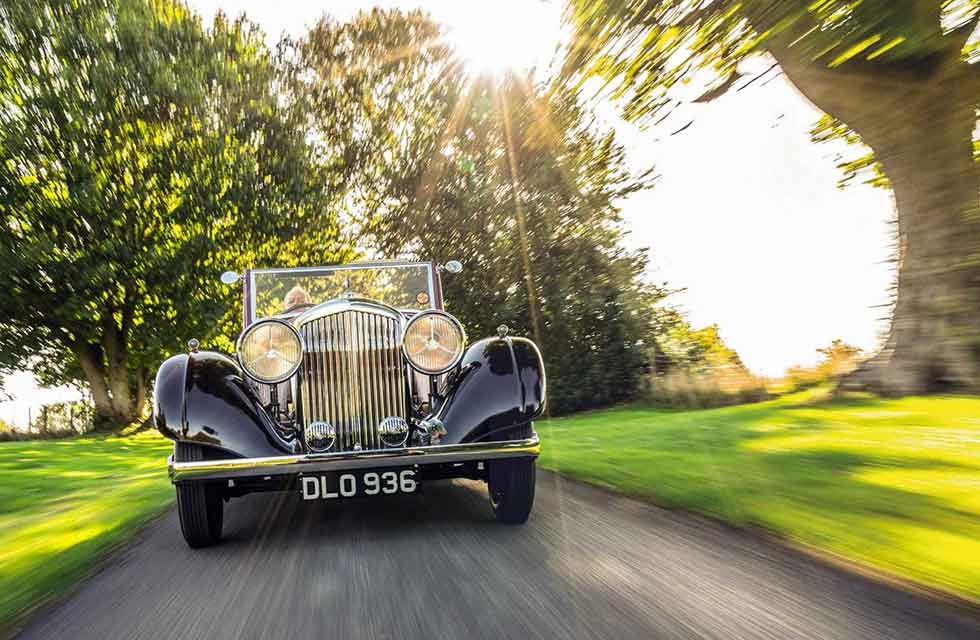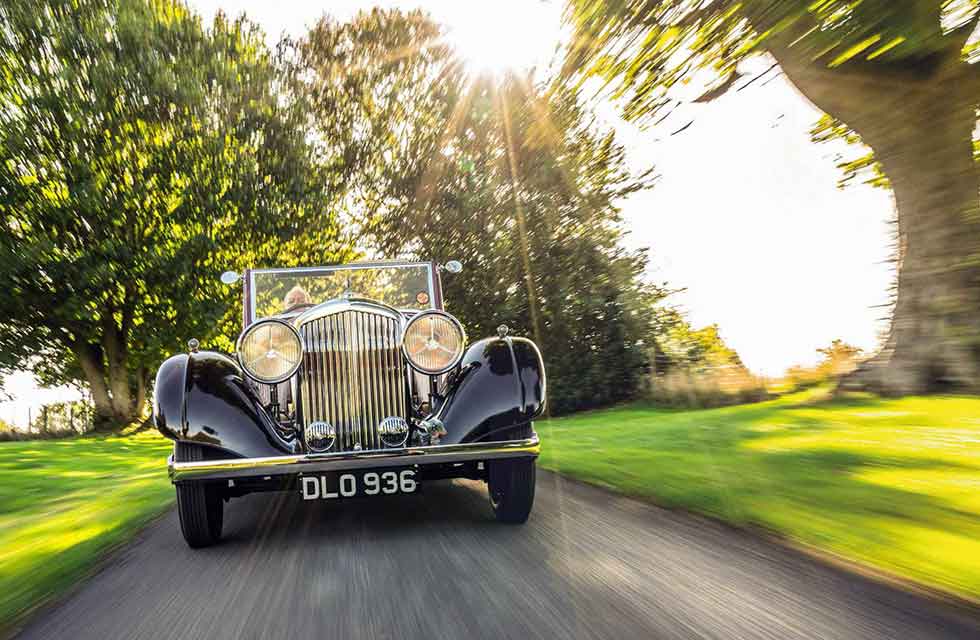
Exclusive! The world’s most original Bentley. Testing a 15,000-mile pre-war 3½ -Litre. W Randolph Angell bought this Bentley 3½-Litre in 1954 – and used it sparingly for 59 years. Now John Simister drives a 15,000-mile timewarp. Photography Tim Andrew.
ANGELL’S DELIGHT THE MOST ORIGINAL BENTLEY
Originality. What does it mean? We know that a car possessing it is prized far above a car that has undergone a total restoration, to a greater degree now than ever before. As is often said, a car is original only once. Once the originality is gone, history is wiped clean.

But one person’s original is another person’s messed-about-with. And when does patina descend into tattiness, timewarp into time-expired? If ‘original’ means ‘as built’, you can even question if any car is truly original for more than the first nanosecond of its existence as an entity. After that, molecule by molecule, things start to change.
In front of me now is a fascinating little book called, yes, Originals. It contains essays in praise of preserved cars, a running theme being the impossibility of total originality and attempts to define, or divine, what it realistically means. After all, as former Brooklands Museum guiding light Allan Winn observes in his contribution, as soon as a car is driven out of the notional darkened, air-conditioned cocoon in which no ultra-violet degradation has occurred, seals have stayed supple and fluids have magically remained fluid, the originality is compromised.
‘The heavy doors close with perfect precision, their gaps astonishingly tight’
He likens it to a 100-year-old bottle of claret, a magnificent possession if kept in a cool, dark cellar, but with a mystique destroyed as soon as the bottle is opened for its intended purpose of drinking the contents. One just has to hope it still tastes good.
With the scene set, please meet this 1937 Bentley 3½ Litre Vanden Plas Drophead Coupe. It has covered just 15,500 miles from new, has never been restored and works perfectly. Its astonishing assemblage of history includes its original order form and sales invoice, its original guarantee certificate in its original cardboard tube with a George V tuppenny postage stamp, and, obviously, its original purple-bound handbook.
And its original paint. Or is it? I’m examining the Bentley on the long driveway of owner Anthony Hodgson’s ample former farmhouse, a full-size glassfibre replica of a Supermarine Spitfire in the background (he used to have a real one, which he flew aerobatically). And, blow me, the paint on the drivers-side rear wing is a bit on the brown side relative to its three very dark maroon companions. It’s a bit more crazed, too. It must have had a repair sometime in the middle of the last century, with paint of a quality slightly lower than that originally used by Vanden Plas, the builder of the Bentley’s ash-framed, aluminium-panelled body. File under ‘patina’, or ‘life’.
This Bentley has, however, been restored – if you take that to mean ‘returned with a light, sympathetic touch to an earlier, better state’ and not ‘made like new with lots of new bits’. Or you might prefer the way Anthony describes what has occurred. ‘I’ve not restored it,’ he says. ‘I’ve just given it a bloody good 15,000-mile service.’
So, how did the Bentley manage to be used so little during its 81 years, and to last so well? The first of its three owners, one Robert S Hayward, Esq, of Galashiels in Scotland, ordered it on 7 September 1936. This must have pleased both Bentley and Vanden Plas greatly, because the chassis (number B135FC) had already been delivered to the bodybuilder on 6 May with a view to building this fourth of the four VdP-bodied drophead coupes (all slightly different) for stock. He paid £1100 for the chassis and £385 for the bodywork, to be finished in ‘two shades of red’ with red leather, and took delivery on 9 March 1937. Building a body for an aristocratic Bentley was not something to be rushed, it seems.
Infrequent use plus the intervention of war and petrol rationing meant that by 1954, when Mr Hayward entrusted Edinburgh Motor Engineering with its sale, the Bentley had covered only 11,000 miles, There it was spotted by W Randolph Angell, born in Massachusetts, settled in Scotland and hopelessly smitten with the pristine car. He couldn’t afford it, had nowhere to keep it, and didn’t even have a driving licence. But his heart overwhelmed his head entirely, spurred on by the pressure of competing interest from a South African collector, and on 7 May 1954 the Bentley became Angell’s for £1350.
Among DLO 936s past papers is a receipt for seven driving lessons dated 8 June 1954, total cost £5 8s 6d. Mr Angell had to learn to drive before he could fully enjoy his Bentley, but in the end he didn’t really drive it much. He kept it stored at the supplying dealer until that garage closed in 1973, then at his house. Some idea of its minimal use is given by MoT certificates from May 1970 and April 1980, with only 165 miles covered between them. And it seems that W Randolph’s son, Randolph Worcester Angell, travelled in it only once: to the Bentley Shell 500 Golden Jubilee celebration at Oulton Park in 1969, recorded by a sticker still attached to the windscreen.
Following his father’s passing, RW Angell put the Bentley up for sale at auction in 2013. It hadn’t moved in over 30 years, perhaps for fear of damaging its ever more precious originality, but fortunately its lair was dry and dark. On seeing DLO 936, Anthony Hodgson was smitten just as his predecessor had been. He realised how significant the originality was, and how easily it could be ruined. So, purchase completed, he set about striking the ideal balance between preservation and function.
And pragmatism, reality even, sometimes have to take precedence. ‘I’ve rewired it,’ Anthony admits. ‘It’s all in the correct cotton look. I’d heard of a chap who used to start up his old vintage car, leave it running and go in for a cup of tea. One day he came back and it had burst into flames.’
Then there are the wheels, re-spoked and re-tyred but with the original hubs and rims, and a minimum of re- chroming taking in the wheel spinners, the bumpers and the horns. All the other chrome is original, apart from a new, additional rear light unit: ‘It only had one, which is all it needed in 1937, but I think it needs two in this day and age. That was another £500…’
And the paint? ‘It had gone chalky, as red tends to, so I T-Cut it. And did it again, Then I polished it. It took a day to do.’ The result is a shine with a sheen rather than a mirror-glaze, just the sort of effect today’s restorers try to achieve when refinishing a pre-war car. Here, it’s VdP’s original finish with just the right evidence of age – apart from that offside rear wing. And a couple of touch-ups by Anthony, and a repainted front apron in a brownish- maroon shade impressively close to the darker of the Bentley’s original hues. It’s actually a Porsche colour.
The long, heavy doors open and close with perfect precision, their gaps astonishingly tight and even. Beyond them, the interior is much as it was when the elder Mr Angell first admired it, the wood’s varnish intact and shiny, the red seats, well, leathery, That is perhaps one of the most tangibly impressive aspects of the Bentley’s reawakening. ‘Decosol! Amazing stuff/ Anthony enthuses, referring to the bright orange, slightly gelatinous liquid that was the go-to upholstery cleaner of the 1970s, ‘but you can’t get it any more. I’ve got just one-and-a-half bottles left.’
Duly Decosolled, the leather was fed with hide food until it was supple again.
There are no cracks and hardly any crumpling, The same goes for the door trims, ‘The door pockets creaked if I tried to move them,’ Anthony reports of his revival efforts, ‘so I had to be very careful.’ The carpets, too, are pristine.
Very slight marks of mould besmirch the inside faces of the instrument glasses, but Anthony didn’t want to disturb the dials’ integrity, The hood, though, is new; the original’s fabric didn’t survive.
And the mechanicals? ‘I had to take the engine to bits after it had sat so long. I didn’t dare run it. Ken Lea [expert on Derby Bentleys and Anthony’s guru for the project] wanted to put new pistons in. He said it would use a quart of oil every 200 miles if we didn’t, but I kept the originals and just honed the cylinder bores, They have their numbers, one to six, and the serial numbers on the crowns. Two had been transposed, presumably from new, so they went 1-2-3-5-4-6. They’ve gone back in that way, of course, so I expect my name will be called when the next person takes the engine apart…’
Anthony spent £1500 on the engine, £1015 of which was to have a new crankshaft damper made by the Ristes Motor Company, The damping part of the spring-loaded ‘Royce crankshaft damper’ consists of wrapped layers of duck cotton, and it’s very labour-intensive to recreate. But 12 parts that, surprisingly, are original are the valve springs, which brings us neatly to the relationship, in the 1930s, between Bentley, the cars’ owners and the chauffeur-mechanics many of those owners employed.
In two of the Bentley’s three toolkits, all complete and beautifully stowed, are spare valve springs and the tool with which to change them by the roadside, as you would. Today it seems extraordinary that such a thing would be deemed normal, especially with a Bentley whose handbook declares, in the chapter entitled ‘The secret of successful running’, that ‘An owner would do well to instruct his driver as follows…’ (cut to the Adjustments section) ‘…not to alter any adjustments unless really necessary’.
With the toolkits are cardboard tubes containing spare bulbs. Are they original too? Could be. Beyond these enchanting details, though, is the bigger picture of a car of great sophistication. ‘It has mechanical memory seats,’ Anthony points out, ‘plus adjustable dampers and a sports mode for the exhaust.’ An exhaust that he has had reproduced in stainless steel, it must be said, because the original had rotted out. Its fixings are the only non-original nuts and bolts on the entire car.
The Bentley is now raised on Anthony’s four-poster lift and I’m looking at the aforementioned high technology, The exhaust has a bypass valve that, when moved by a lever in the cabin, allows flow out of its side instead of through the rearmost silencer and tailpipe. And a pump in the gearbox pressurises the suspension dampers to a driver-selectable degree when required, thus firming-up the ride. Other underside intrigue includes the pipework for the one-shot, pedal-operated, chassis lubrication system and a gearbox- driven brake servo.
Under here it’s all dark brown, not black as you might expect. ‘It was covered in half a century of oil,’ Anthony says, ‘and it took a day to get it all off. I touched up all the chips and marks with matching brown paint, then sprayed matt lacquer over it all to preserve it.’ All but one of the gaiters over the leaf springs and balljoints are original. So, incidentally, is the fanbelt. ‘It was solid when I took it off, but I soaked it in engine oil for two days until it was supple. It’s fine now.’
Anthony has swapped the final drive for a longer-legged one, and has replaced the clutch because Mr Angell had destroyed it – perhaps while learning to drive, The brakes retain their original linings, though. In all, our hero has spent at least 1500 hours bringing the Bentley back to life, spending around £20,000 in the process with various specialist suppliers. Fiennes Restoration, steeped in the breed, accounted for about £11,000 of that, the accumulation of endless cables, bushes, mountings, gaskets, drip plugs, that exhaust system and much, much more.
Having undergone all this work, is the Bentley still ‘original’? It’s as original as it reasonably can be while functioning as it should, the items replaced mostly having been consumables, safety-related or both. Yes, many of its sub-assemblies have been apart to ensure they can work properly, but no more than would normally happen during maintenance typical of such a car’s life, The structural and cosmetic integrity of DLO 936 has not changed since it was new in 1937. That’s original enough for me – and probably for Allan Winn, too.
Now, after ‘three head-tightenings and three oil changes in 150 miles’, the Bentley is running beautifully. Its trafficators plop obediently up and down, it feels solid on the road and its back seat is envelopingly comfy. My brief drive reveals a precise, ultra-mechanical action from the narrow-gated, right-hand-actuated gearchange, spring-loaded to the right, synchronised only on third and top, and whose entry-obstructing position is the reason for that slide-back memory seat, The steering is lighter and more accurate than I expected once above walking pace, and the whole car has that all-of-a-piece aura to match its minimal mileage.
The revcounter scale runs to 5000rpm with a redline at 4500, which sounds quite speedy for a 1930s Bentley. If I pull the sports exhaust handle, DLO 936 changes from ‘the silent sports car’ (as advertised in period) to quite a rorty one; I prefer it silent(ish). Cere’s plentiful torque, as you would expect, and once you’re past 30mph the brake servo comes into play, upon which the pedal’s response sharpens significantly. It all works very nicely.
Anthony then takes us for a longer drive on the old A55, up and down sweeping hills and bends as I luxuriate on that rear sofa, The Bentley feels as spirited as it probably did when new, as well it should. Time travel, clearly, is not a fantasy, because I’ve just experienced it.
So, if the Bentley were yours, what would you do with it now? Tuck it away as a timewarp curio, or use it in the knowledge that the experience is as period-correct as it can possibly be? I’d do the latter. You could always restore it later, should it be necessary, but it’s original only once. So why not savour the moment?
THANKS TO H&H Auctions, www.handh.co.uk.
TECHNICAL DATA FILE SPECIFICATIONS 1937 Bentley 3 ½ Litre Vanden Plas Drophead Coupe
Engine 3669cc OHV straight-six, iron block and head, aluminium crankcase, two SU carburettors
Max Power Approx. 110bhp @ 4500rpm / DIN nett
Max Torque Approx. 321lb ft @ 2300rpm / DIN nett
Transmission Four-speed manual, synchromesh on third and top, rear-wheel drive
Steering Worm and nut
Suspension Front and rear: beam axles (live rear), semi-elliptic leaf springs, hydraulic dampers
Brakes Drums, servo-assisted
Performance
0-60mph 19.5sec
Max Speed 90mph
Facing page. The hood’s new, the wheels respoked and their spinners rechromed, and, er… that’s about it, really. Even the majority of the paint is as applied by Vanden Plas in 1937, brought back to life after a day with a bottle of T-Cut and polish.
Clockwise from above. 81 years old yet as close to new condition as it’s possible to be – thanks to Anthony Hodgson; honed cylinder bores and a new crankshaft damper revitalised the engine; new hood is one of a handful of replacement parts; evidence of a rare trip out in 1969; original -and complete – toolkit.






